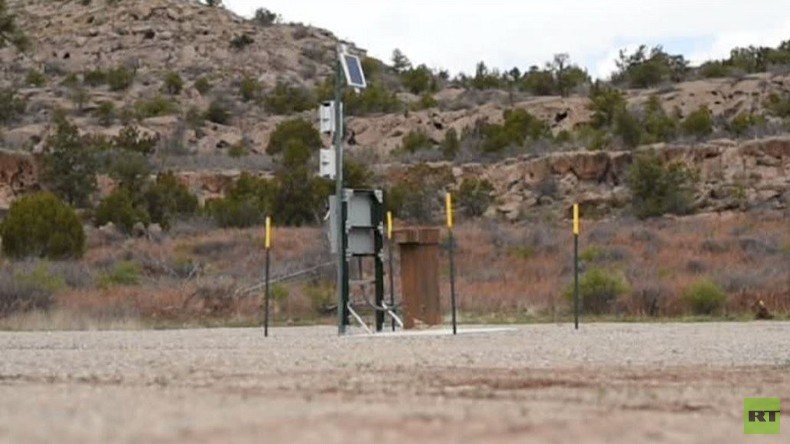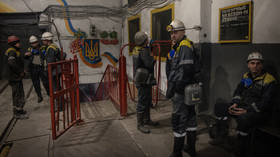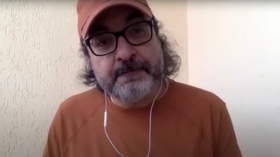Chromium plume from Los Alamos threatens New Mexico Native American tribe, drinking water

Hexavalent chromium may not be familiar to the average American ‒ but Erin Brockovich likely is. A plume of the same toxic chemical that led to a movie based on Brockovich is now threatening a Native American tribe’s sacred lands and a major aquifer.
Chromium-6 (aka hexavalent chromium) lines the cooling towers at Los Alamos National Laboratory in northern New Mexico. For nearly two decades, from 1956 to 1972, the birthplace of the nuclear bomb flushed water from its cooling system ‒ water contaminated by the corrosion-preventing chemical – into Sandia Canyon.
Since then, the runoff has created an underground chromium plume that is a mile long by half a mile wide and 100 feet thick. It’s threatening drinking wells, a major aquifer, and the San Ildefonso Pueblo’s sacred tribal land, which borders the federal property. The plume was discovered during the installation of a groundwater monitoring well in late 2005, according to Los Alamos.
Scientific research ‒ and the lawsuit against Pacific Gas and Electric, for which Brockovich served as a legal clerk ‒ has shown that drinking water tainted with high levels of chromium-6 is linked to cancer. In 2010, the Environmental Protection Agency (EPA) proposed classifying the chemical as “likely to be carcinogenic to humans when ingested.” It has set a maximum contaminant level for all types of chromium, including the hexavalent variant, at 100 parts per billion.
Los Alamos says that addressing the chromium plume is one of its “highest environmental priorities.” In 2014, the lab installed a pilot pumping well and conducted short-term pilot-scale pumping “to evaluate the feasibility of hydraulically controlling migration of the plume.” Eventually, Los Alamos hopes to “achieve and maintain” a plume edge of less than 50 parts per billion “within the Laboratory boundary.”
But the San Ildefonso Pueblo’s sacred tribal land isn’t within the lab’s boundaries. Today, the Pueblo (or community) stretches across 60,000 acres and is home to about 750 people. It’s history dates back to 1300 CE, when the tribe’s ancestors lived in the caves down the road from the current Pueblo. The sacred land is reserved for hunting, gathering and spiritual practices.
San Ildefonso Governor James Mountain explained to RT America’s Simone Del Rosario how the toxic plume is affecting the Pueblo.
“Make no mistake, just because we’re not physically living here, that doesn’t mean that we don’t live here, if that makes sense. Because we’re here every day and the spirit is here every day,” he said as they drove through the sacred land.
The US Department of Energy has informed the tribe that they’ve “detected traces of chromium plume contamination up to the fence, but they couldn’t confirm it on this side,” Mountain said. “Pretty obvious it exists on our side.”
“The only thing that separates us is what I call ‘the magic fence’,” he added. “I’m told that the contamination of the chromium plume is detected up to the fence, and this magic fence is made up of three-strand barbed wire fence, and it just magically keeps the contamination on that side and it doesn’t come over to our side.”
The government asked the Pueblo if it could drill a testing well into the sacred land to find out for sure whether the plume has reached the area. It was a difficult decision to make for the San Ildefonso people.
“It was heavily debated, and it was a hard decision but leadership came together and we worked together to make that informed decision,” Mountain said. “There was truly spiritual and physical effect and feeling once that drilling started happening.”
The testing site is seen as a scar on the sacred land, albeit a necessary one.
“We cannot continue to bang our fist on the table and say, ‘You took my land and you contaminated my land, give us money’, because that’s not gonna get us anywhere,” the governor told RT. “It is what it is. It’s just the part of life that we have to deal with and that my generation has inherited, but once again it goes back to owning it on our part and taking it head on and having a clear understanding of what’s going on so we can have that seat at the table.”
Indeed, the Pueblo does have a seat at the table. In December 2014, the tribe signed a memorandum of understanding with the lab and the Department of Energy.
“There’s that mutual respect there, and that’s a good start because this is gonna be a long term issue we’re gonna have to be dealing with,” Mountain said.
Del Rosario tried to speak to the government about the plume.
“After speaking with all of the involved parties over the phone, we traveled nearly 2,000 miles to tell this story and show not only what is the problem, but how the government is working to fix it,” she said. But once the RT team arrive, the Department of Energy denied them access to the lab.
New Mexico fines federal government after nuclear waste radiation leaks http://t.co/gj0PM22ElYpic.twitter.com/JCGEmCX0Pr
— RT (@RT_com) December 7, 2014
Regardless of the contamination, though, the governor refuses to let it affect his way of life or that of his people.
“If the grounds are contaminated, if the water down below is contaminated, I would still not hesitate to harvest a deer that’s contaminated,” Mountain said. “It’s a way of our life and that’s what’s being threatened. And it’s not about me, this is about my people, the people of San Ildefonso.”













